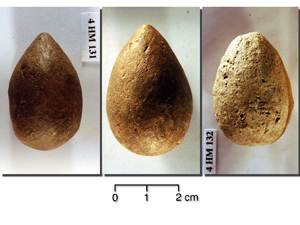|
||
      |
Hamoukar at war
Oriental Institute archaeologists unearth new details about how civilization’s oldest city prospered and perished.

More than 1,100 sling bullets were found at Hamoukar.
On its last day, the ancient city of Hamoukar, in what is now northeastern Syria, burned to the ground. Roofs crumpled and clay bullets rained down as invaders overran the city walls. “The attack must have been swift and intense,” says Oriental Institute archaeologist Clemens Reichel, AM’94, PhD’01, who codirects the OI and the Syrian Department of Antiquities’ joint Hamoukar expedition. “Buildings collapsed, burning out of control, burying everything in them under vast piles of rubble.”
University researchers have been excavating Hamoukar, near the Syrian-Iraqi border, since 1999. New findings released this past January offer fresh details not only about the assault that destroyed the walled city around 3500 BC but also how urban life may have begun in that same spot as much as a millennium earlier. When they first began digging, archaeologists determined that city life developed there independent of—and likely before—southern Mesopotamian cities long considered the birthplace of urban society.
Since 1999 the Syrian-American team had excavated a city wall, several manufacturing workshops, and two large administrative buildings destroyed by fire. The 2005 discovery of more than 1,200 egg-shaped sling bullets, mixed in with debris from the collapsed walls, led them to conclude that a war had destroyed the settlement. This past season the team uncovered 1,100 more bullets, along with details of the battle’s preparation and aftermath. “We found sling bullets at literally all stages of use, from manufacture to impact,” Reichel says. One bullet had even pierced the plaster of a mud-brick wall.
Hamoukar’s defenders resisted the attack, employing everything they had to produce weapons. In a shallow pit ordinarily used to soak and recycle discarded clay seals, the sealing clay was turned instead into sling bullets. Excavators found two dozen of them neatly lined along the pit’s edge. “It looks as if they were—quite literally—throwing everything they could find against the aggressors,” Reichel says. In the debris of the buldings the team also found 12 graves, likely dug for war casualties.
Hamoukar sat along a key trade route from Anatolia (modern-day Turkey) across north-ern Syria and the Tigris River into southern Mesopotamia. This past year Reichel and his colleagues discovered evidence of the long-lasting trade south of Hamoukar’s main site. There, in an area more than 700 acres wide, the team excavated thousands of fragments of obsidian tools and blades, which they dated to 4500–4000 BC. The team also discovered obsidian cores (rocks from which blades were made) and other production debris. The find shows that Hamoukar residents were “not just using these tools here” but also “making them here,” explains Salam al-Kuntar, the expedition’s Syrian codirector. Yet obsidian, not native to Hamoukar, had to be brought in from Turkey; the nearest source was 70 miles away.

Obsidian cores were used to make blades.
Located off the main mound, the obsidian workshops predate the destroyed city by several hundred years and could explain, Reichel says, urban society’s emergence so far north of other early cities. Ex--porting manufactured tools to southern cities would have brought significant revenue and wealth to Hamoukar. “This could have been the incentive that pulled people off their fields,” he says. Instead of plowing their own subsistence farms, they specialized in other work and imported food from surrounding villages. “And once people started to accumulate a fortune, they wanted a walled enclosure to protect it—your first city.”
Test trenches dug on the main mound have uncovered numerous older occupation levels below the destroyed buildings, indicating that the incinerated city was only the latest phase of a long settlement sequence. “We have no clear idea how far the first city at Hamoukar goes back in time,” Reichel says. “It could be much earlier than 3500 BC.”
The emergence of an urban center at Hamoukar before 3500 BC—almost 1,000 years earlier than most other Syrian cities developed—has remained a mystery. In southern Mesopotamia irrigation-based agriculture required a highly organized labor force, providing a strong momentum for urban social and economic differentiations. Northern Syria’s rain-fed agriculture offered no such incentives; to this day village-based life dominates there. But the discovery of Hamoukar’s obsidian workshops suggests that trade and manufacturing wealth, which triggered the emergence of a specialized class of craftsmen, lured north Syrian villagers into the confines of the Hamoukar site’s earliest city.